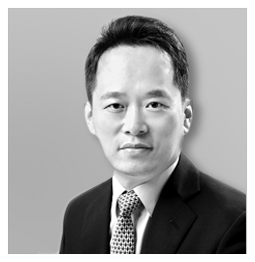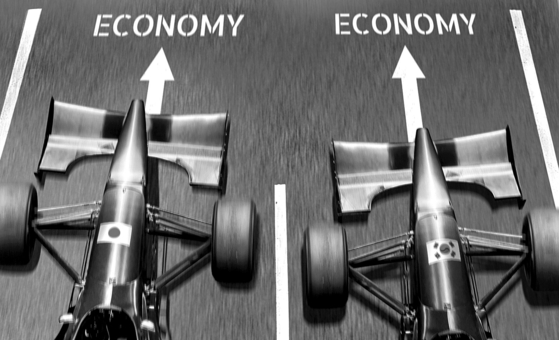The real game starts now

The author is an editorial writer of the JoongAng Ilbo.
Katsuhiro Kuroda, a former Seoul bureau chief for Japan’s Sankei Shimbun, had no ill designs in the writing of his 2006 book “The Korea that can Never Escape from Japan.” As the title made clear, its theme was Korea’s heavy economic reliance on Japan. He was not exaggerating. Korea has become an advanced nation in many regards, but has not reached Japan’s level in technology.
However, dramatic transformations are in the making. What looked impossible is taking place now. Korea was mostly a copycat of Japan in key industrial areas of shipbuilding, steelmaking, automobile and semiconductors.
The turnaround in chipmaking has been the most staggering of all. In the early days, engineers from Samsung Electronics managed to finagle invitations to Japanese factories. On their tours, they paid close attention to what they saw, especially of Japanese chip designs. As soon as they returned to their hotel rooms, they committed to paper everything they could remember from their factory tours.
Japan was not overly stingy in sharing its advanced technology with Korea. Posco could never have achieved its steelmaking standards if not for the capital and technology assistance from Japan. Japan was eager to help Korea as it felt indebted to Koreans for their sufferings from the colonial period, said an official from the Japanese foreign ministry.
In this way, Korea benefited from the Japanese tutoring and set the foundations for its rapid economic development. In terms of coping with the new coronavirus pandemic, Japan has not been able to match Korea. That shows how much Korea has matured in its industrial and medical infrastructure.
The 1988 Seoul Summer Olympic Games were a turning point for the Korean economy. Korea showed the results of its remarkable advances across the board. Nevertheless, it suffered a chronic trade deficit with Japan. The trade deficit with Japan topped $30 billion a year at the time. In his 1988 book entitled “Collapse of South Korea,” Naoki Komuro, a famous commentator, compared the Korean economy to cormorants, which have to vomit fish after swallowing them to please their owner. (The idea is that Korea’s exports benefit Japan due to its high reliance on materials, parts and equipment from Japan.)
Korea’s accumulated trade deficit with Japan reached $623.7 billion last year from the point the two countries normalized ties and trade in 1965.
But the trade deficit with Japan last year hit a 16-year low of $19.2 billion. Imports from Japan fell 12.9 percent on year to $47.6 billion. At the same time, Japan’s share of Korea’s imports slipped to 9.5 percent from 10.2 percent. Korea’s exports to Japan also fell 6.9 percent to $28.4 billion, which means Korea lessened its reliance on Japan in both imports and exports.
That was the result of a trade war Japan waged against Korea. Last July, Tokyo curbed exports of key materials for semiconductors and displays — hydrogen fluoride, fluorinated polyimide and photoresists — to Korea. Goldman Sachs worried about a disruption in the global supply chain for chipmaking. But that did not happen.
The Korean chip and display industries did not collapse when supplies stopped from Japan. Korea has been successfully weaning itself off Japan and achieved self-sufficiency to some extent. Such independence is a near miracle.

Since choices of local companies are restricted under the usual industrial structures, competitive superiority should be considered in trading, as Ricardo argued. In the same vein, East Asian economies have completed the global supply chain — with Japan providing key materials and components for industrial production, Korea making the intermediary products, and China assembling them into finished goods. Each economy has its own strength in certain areas. Harvard Business School Professor Michael Porter had a different theory of competitive advantage. He claimed that just because a company is a market leader now, doesn’t mean it will be forever. Korean enterprises showed how they could make it.
Ricardo could not have taken individual corporate capabilities into account in his days of the 18-19th centuries. But companies in the 20th and 21st century have built their own capabilities and overcome limitations on home ground. By recruiting talents at home and abroad, Samsung Electronics internalized technologies needed to achieve a competitive edge. It outpaced Japan in chip production and groomed a supply chain at home. There are numerous semiconductor equipment makers trading publicly in Korea, including SoulBrain. Local equipment makers total 38, integrated circuit makers 19, 3D NAND flash memory producers 15 and smartphone-related suppliers 37.
The Diplomat, an online journal in the United States, found that the overall damage from Japanese export restrictions on Korean chipmakers last year was limited.
The export restrictions only accelerated Korean self-sufficiency. The government pledged a 2.1-trillion-won ($1.7 billion) investment to groom IT materials and equipment makers. It set up a national committee to promote the sector at home and diversify imports away from Japan. SoulBrain has begun mass-production of hydrofluoric acid with a purity level of 99.9999999999 percent, which used to be only possible in Japan.
Foreign capital has also been zeroing in on the burgeoning materials activities in Korea. Lam Research, a global manufacturer of semiconductor equipment in the United States, moved its research and development center to Korea. DuPont is building a new 60-billion-won factory to produce photoresists in Korea. The Moon Jae-in administration has fast-tracked its permission procedure for chemical materials production in Korea and allowed overtime to remove regulations on the manufacturing front. The Materials Act — revised for the first time in 20 years to promote the field — has been effective since April 1.
Japan has been taken aback by our backlash. Koreans traveling to Japan halved in the latter half of last year as Koreans voluntarily boycotted anything related to Japan in reaction to its trade restrictions. Anything made-in-Japan, including Toyotas, Uniqlo t-shirts and Asahi Beer, was hard-hit. Tokyo has recently been restraining its actions and rhetoric. Its retaliatory moves only exposed its weakness and Korea’s strengths. Korea must not waste itself in self-indulgence and nationalism, but use its newfound confidence to move forward.
JoongAng Ilbo, May 8, Page 23










with the Korea JoongAng Daily
To write comments, please log in to one of the accounts.
Standards Board Policy (0/250자)